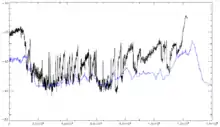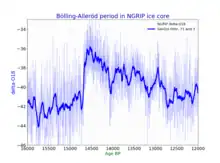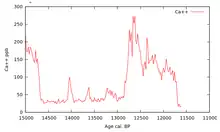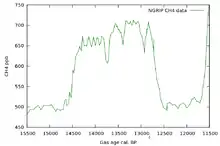North Greenland Ice Core Project
The drilling site of the North Greenland Ice Core Project (NGRIP or NorthGRIP) is near the center of Greenland (75.1 N, 42.32 W, 2917 m, ice thickness 3085). Drilling began in 1999 and was completed at bedrock in 2003.[1] The cores are cylinders of ice 11 centimeters in diameter that were brought to the surface in 3.5-meter lengths. The NGRIP site was chosen to extract a long and undisturbed record stretching into the last glacial, and it succeeded. The site was chosen for a flat basal topography to avoid the flow distortions that render the bottom of the GRIP and GISP cores unreliable. Unusually, there is melting at the bottom of the NGRIP core - believed to be due to a high geothermal heat flux locally. This has the advantage that the bottom layers are less compressed by thinning than they would otherwise be: NGRIP annual layers at 10.5 kyr age are 1.1 cm thick, twice the GRIP thicknesses at equal age.




The NGRIP record helps to resolve a problem with the GRIP and GISP2 records - the unreliability of the Eemian Stage portion of the record. NGRIP covers 5 kyr of the Eemian, and shows that temperatures then were roughly as stable as the pre-industrial Holocene temperatures were. This is confirmed by sediment cores, in particular MD95-2042.[2]
In 2003, NGRIP recovered what seem to be plant remnants nearly two miles below the surface, and they may be several million years old.[3]
"Several of the pieces look very much like blades of grass or pine needles," said University of Colorado at Boulder geological sciences Professor James White, an NGRIP principal investigator. "If confirmed, this will be the first organic material ever recovered from a deep ice-core drilling project," he said.
References
- "Breaking through Greenland's ice cap". 23 July 2003.
- "WorldChanging: Not-So-Abrupt Climate Change?". www.worldchanging.com. Archived from the original on 6 October 2008. Retrieved 12 January 2022.
- "Archived copy". www.glaciology.gfy.ku.dk. Archived from the original on 5 October 2011. Retrieved 12 January 2022.
{{cite web}}: CS1 maint: archived copy as title (link)
External links
The original web page of the NGRIP project with field diaries and pictures.
The NGRIP project was run by an international consortium of scientists, and drilling and logistics were managed by what is now called Centre for Ice and Climate at the Niels Bohr Institute, University of Copenhagen, Denmark. This research centre maintains a web page about ice core research: